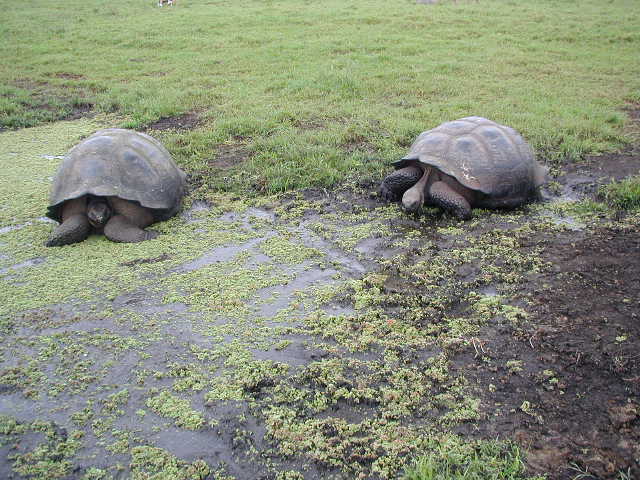
Our visit to Santa Cruz was quite different from those to the other islands. The town of Puerto Ayora has a population of about 10,000 and is the commercial center of the archipelago. We began with a trip to the Charles Darwin Research Station. The station activities include a range of research projects, but the best known is the giant tortoise breeding program. Tortoises are bred in captivity and raised to be released back to the wild. One piece of tortoise trivia is that there are two basic types of carapaces (shells). Tortoises from some some islands have dome-shaped shells, while those from others have saddleback shells. The latter are responsible for the name of the archipelago as Galapagos comes from an old Spanish word for a type of saddle. It is also alleged that the giant tortoise was the inspiration for E.T.. The most famous single tortoise is Lonesome George, who is the only known Pinta Island tortoise alive. They've tried to breed him with females belonging to a similar subspecies but he hasn't shown any interest.

The other "named" tortoise that was pointed out was Diego, who used to be in the San Diego zoo and whose shell is cracked since he used to beat it against his enclosure. We walked through a couple of large pens, where we saw many more tortoises. One notable behavior is that they stretch their necks out quite long so that birds (e.g. yellow warblers) will clean them of ticks.
After stopping at the station shop, we had free time to explore the town. I bought a t-shirt at the research station on the grounds that it supports a good cause. But you can find t-shirts showing pretty much any of the wildlife you might favor at the souvenir shops along the main street. The town is quiet and pleasant enough and quite low-key. I did buy several postcards and a stuffed animal (a blue-footed booby) for my collection. Incidentally, I noticed a few internet cafes but didn't bother trying any of them.
From the town, we had a half hour bus ride to the highlands, to a restaurant called Altair. Some people played volleyball and a few swam in the pool, while we waited for lunch. Jacqueline de Roy (Tui's mother) was there, with an assortment of silver jewelry she had made, depicting various animals. After eating, we had various options. I selected the "do it all" one which started with a visit to Los Gemelos, a pair of pit craters, somewhat similar to Trou aux Cerfs in Mauritius. Here, the craters are surrounded by Scalesia forest. Scalesia is related to the daisy, but in the highlands of Santa Cruz Island it grows into large trees. The walk around one crater was a bit rough, and I'd have liked to have had my walking stick for a few slippery spots. It was still worthwhile to see the difference between the cool, misty highlands and the coastal areas we'd visited on other islands. There were just a few birds, e.g. ground finches in the trees and tree finches on the ground. No, I'm not confused; the finches are!
We continued on to a farm where we could see giant tortoises in the wild. It was quite amusing to see them in the paddocks, right next to the horses and cattle. I have to admit that they're pretty much on the bottom of my personal endemic animal cuteness scale and that, frankly, I prefer livelier critters.

As we were leaving the farm, we saw a vermillion flycatcher, which is the most amazingly bright red bird one can imagine. At least the males are; the females are quite drab. He finally flew down to within picture taking distance - and, of course, that was the moment that my camera batteries died.
The evening recap included a talk by a woman named Roz from the research station. She emphasized the problems with introduced species. For example, scale insects have now reached even the outermost islands. The work to rid the islands of introduced species is continuing but is complex and costly. For example, it's important to get rid of pigs before getting rid of goats, since without the goats the vegetation grows high enough that pigs can hide in it.
After dinner, there was music in the lounge by a group called Galapagos Identidad. The instruments included a guitar, a charengo (stringed instrument resembling a ukulele in appearance), a drum, a sort of rattle they claimed was made from goats' toenails, a flutelike instrument called a quena and a sort of panpipes called a rondador. The music was similar to other South American music I've heard. (Inti-illimani is the first group that comes to mind, but there was an excellent Peruvian group who used to play outside one of the museums in Edinburgh when I was there.) The musicians were accompanied by three women who did a couple of traditional dances, one involving skeins of yarn and another with a lot of motion of their hats. Then they put on dresses with white skirts featuring hand-painted scenes of Galapagos wildlife. Passengers were invited to join in the dancing, which some did, with varying degrees of reluctance. The most enthusiastic dancer, though, was Rafael's two year old daughter.
Back to Previous Chapter | Back to Ecuador Index | On to Next Chapter | Xenophilia Home
last updated 20 January 2002